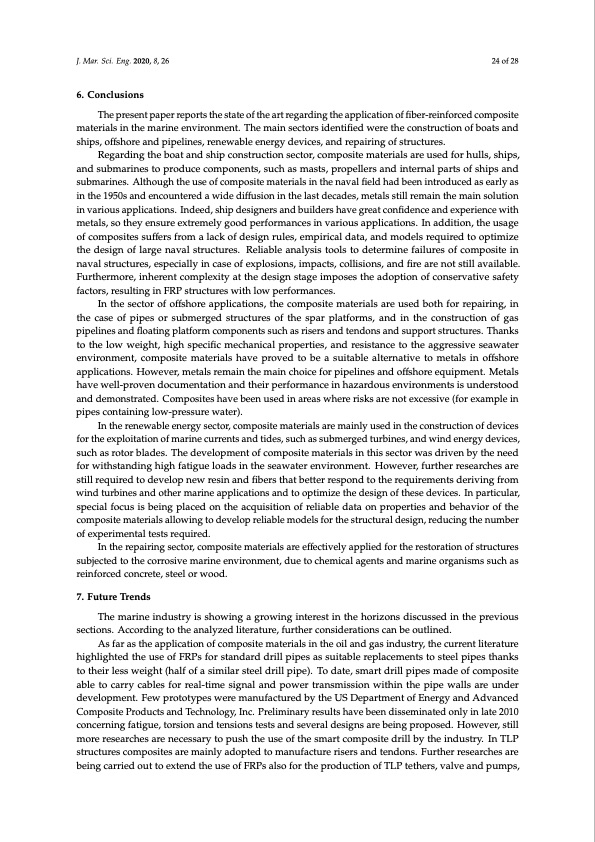
PDF Publication Title:
Text from PDF Page: 024
J. Mar. Sci. Eng. 2020, 8, 26 24 of 28 6. Conclusions The present paper reports the state of the art regarding the application of fiber-reinforced composite materials in the marine environment. The main sectors identified were the construction of boats and ships, offshore and pipelines, renewable energy devices, and repairing of structures. Regarding the boat and ship construction sector, composite materials are used for hulls, ships, and submarines to produce components, such as masts, propellers and internal parts of ships and submarines. Although the use of composite materials in the naval field had been introduced as early as in the 1950s and encountered a wide diffusion in the last decades, metals still remain the main solution in various applications. Indeed, ship designers and builders have great confidence and experience with metals, so they ensure extremely good performances in various applications. In addition, the usage of composites suffers from a lack of design rules, empirical data, and models required to optimize the design of large naval structures. Reliable analysis tools to determine failures of composite in naval structures, especially in case of explosions, impacts, collisions, and fire are not still available. Furthermore, inherent complexity at the design stage imposes the adoption of conservative safety factors, resulting in FRP structures with low performances. In the sector of offshore applications, the composite materials are used both for repairing, in the case of pipes or submerged structures of the spar platforms, and in the construction of gas pipelines and floating platform components such as risers and tendons and support structures. Thanks to the low weight, high specific mechanical properties, and resistance to the aggressive seawater environment, composite materials have proved to be a suitable alternative to metals in offshore applications. However, metals remain the main choice for pipelines and offshore equipment. Metals have well-proven documentation and their performance in hazardous environments is understood and demonstrated. Composites have been used in areas where risks are not excessive (for example in pipes containing low-pressure water). In the renewable energy sector, composite materials are mainly used in the construction of devices for the exploitation of marine currents and tides, such as submerged turbines, and wind energy devices, such as rotor blades. The development of composite materials in this sector was driven by the need for withstanding high fatigue loads in the seawater environment. However, further researches are still required to develop new resin and fibers that better respond to the requirements deriving from wind turbines and other marine applications and to optimize the design of these devices. In particular, special focus is being placed on the acquisition of reliable data on properties and behavior of the composite materials allowing to develop reliable models for the structural design, reducing the number of experimental tests required. In the repairing sector, composite materials are effectively applied for the restoration of structures subjected to the corrosive marine environment, due to chemical agents and marine organisms such as reinforced concrete, steel or wood. 7. Future Trends The marine industry is showing a growing interest in the horizons discussed in the previous sections. According to the analyzed literature, further considerations can be outlined. As far as the application of composite materials in the oil and gas industry, the current literature highlighted the use of FRPs for standard drill pipes as suitable replacements to steel pipes thanks to their less weight (half of a similar steel drill pipe). To date, smart drill pipes made of composite able to carry cables for real-time signal and power transmission within the pipe walls are under development. Few prototypes were manufactured by the US Department of Energy and Advanced Composite Products and Technology, Inc. Preliminary results have been disseminated only in late 2010 concerning fatigue, torsion and tensions tests and several designs are being proposed. However, still more researches are necessary to push the use of the smart composite drill by the industry. In TLP structures composites are mainly adopted to manufacture risers and tendons. Further researches are being carried out to extend the use of FRPs also for the production of TLP tethers, valve and pumps,PDF Image | Marine Application of Fiber Reinforced Composites

PDF Search Title:
Marine Application of Fiber Reinforced CompositesOriginal File Name Searched:
jmse-08-00026.pdfDIY PDF Search: Google It | Yahoo | Bing
Development of a solar powered Electric Ship The Electricship website originally started off as a project to develop a comprehensive renewable, affordable, modular electric ship... More Info
Modular Boat Hull Composite The case for a unsinkable, modular composite hybrid boat hull... More Info
MS Burgenstock Hybrid Electric Catamaran Lake Lucerne Unique shuttle servicing Lucerne to the Burgenstock Resort... More Info
Ground Power Unit GPU Powered by Lithium Ion Batteries The goal of the Ground Power Unit is to provide a readily accessible, modular, ready-to-power solution for remote power... More Info
| CONTACT TEL: 608-238-6001 Email: greg@electricship.com | RSS | AMP |